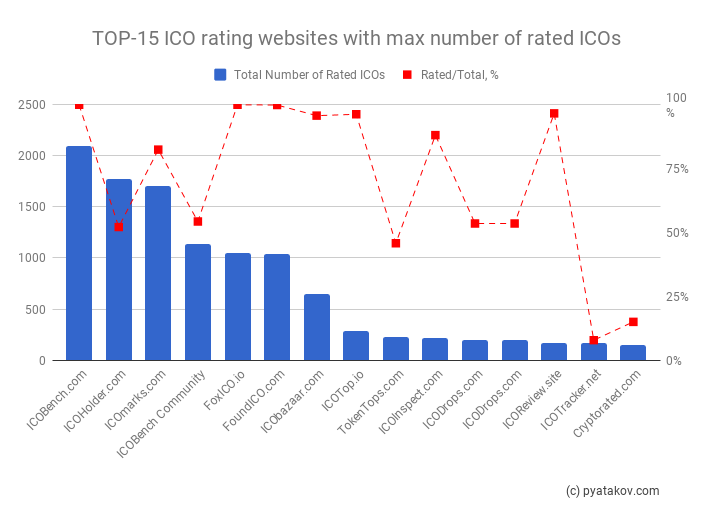Disclaimer: Data present in this research is only relevant just at this particular moment, i.e. beginning of March 2018.
Introduction
If you are looking for information on how particular ICO is evaluated by others, you have a lot of opportunities. Today there are more than 30 services, which aim to provide you with various ratings on ICOs. And I do not even mention those, who are building (or raising money to build) some distributed blockchain rating system.
So I decided to conduct some research, what is out there that ICO ratings services have to offer us. I examined 30 services (and not only), which provide ratings for ICOs. I examined only those that was actually been able to quickly find on the Internet. I am sure that there are a lot more of them.
This research will be split into 3 parts:
- First we will examine the ICO rating services and measure some quantitative and qualitative metrics to get a better understanding of ICO ratings landscape.
- Then we will measure various statistics considering ICO service listings
- Finally we will dig into the ratings provided by these services and will try to find any meaningful insights and comparisons.
List of targets
Here is the full list of examined Rating services:
Fun fact: 19 out of 30 website names start with “ICO”.
General stuff
How old are ICO Rating services?
Although that might be a very imprecise metric, yet we can drive some conclusions based on when were their domains registered.

Not surprisingly most domains were registered in 3Q 2017, when the ICO hype started. The few were registered long before the hype wave are:
- ICORating.com (Aug 2016)
- ICOTracker.com (Sep 2016)
- Buddhatrader.com (Dec 2016) - yet not a fair comparison as they focus not only on ratings
- ICObazaar.com (Apr 2017)
One may also notice that by the end of 2017 the amount of newly registered websites lowered or may be they haven’t yet come to prominence.
How much web traffic do ICO Rating websites have?
As for most visited websites there are 2 definite leaders.


Compared to various currency exchanges websites (~200 M monthly views) or Coinmarketcap.com (~360 M monthly views), popularity of ICO rating websites is underwhelming and probably has great potential to increase.
Typical dynamic of monthly visits for an ICO Rating website usually looks like this.

ICO coverage
How many ICOs are listed on the websites?
As ICOs do eventually end, ICO databases tend to become out of date. In order to stay relevant ICO services must constantly update their databases. That’s why we also measure the amount and % of lists upcoming ICOs.
The numbers of the chart are the total amount of ICOs, including ICOs which did not receive ratings.


13 services are present in both charts. And it is a good sign that they are both big and relevant.
You may also notice that ICO coverage does indeed differ among the websites. Before the research I assumed that many services would just prefer an easier way of scraping each others’ data (some websites even do proved an API to their data) and thus I expected to see much more closer numbers. Turned out this is not the case.
How many ICOs are actually being rated?

The second parameter “Rated/Total” shows the percentage of rated ICOs compared to all ICOs listed by that site. When it’s close to 100%, it may indicate one of two options:
- Either all ICOs are automatically-analyzed (supervised or not) to produce a rating. And that’s usually the case for the sites with larges listings.
- Only rated ICOs are being listed.
I also set apart “ICO Bench Community”. This is the number of ICOs which were rated by experts from community and not just by ICO Bench itself.
Two sites who have only community ratings are not present in this top: WiserICO and ICOVoting. I decided to leave them out, because:
- On the one hand, they do allow any ICO to be rated by registered users. Id means that they may have 100% rating coverage.
- On the other hand, it is so easy to register on these websites (no validation except working email is required), so it diminishes the meaningfulness of these ratings.
Study of whether do all services rate the same list of ICOs is left for part 2 of the research.
ICO Rating trends
Which ratings are preferred: “Scores” (e.g. “4.5” or “87%”) or “Grades” (e.g. “AA+” or “Positive”)?

How do ICO rating services bother to explain what and how exactly they are rating?

Unfortunately only a third of websites to provide more or less detailed description of how they arrive at their rating conclusion. And a third of websites do not comment their ratings at all. In my opinion, lack of any disclosed methodology is a serious drawback for a ICO Rating service.
Which ICO rating “features” are most popular?

Now these features need some explanation:
- “Expert Rating”: ICO Rating websites state that they use their own judgment and expertise to determine final ratings.
- “Subratings”: Some detailed components of final ratings are available. E.g. “Team”, “Product”, “Vision”.
- “Automated”: ICO Rating websites mention that they calculate ratings automatically (both with or without human supervision).
- “Community”: Final ratings are calculated based on scores and ratings of various experts from community.
- “Aggregated Rating”: ICO Rating services state that they calculate their ratings based on available ratings from other rating providers.
- “Spreadsheet”: Rating calculation is actually done and publicly available in form of a spreadsheet (e.g. Google Spreadsheet).
Conclusion
Thanks for reading. If you have any questions or ideas please feel free to comment this post or contact me directly.
Part 2 of this research is to come out in 1-2 weeks. In part 2 we will examine the actual ratings. Please stay tuned.
